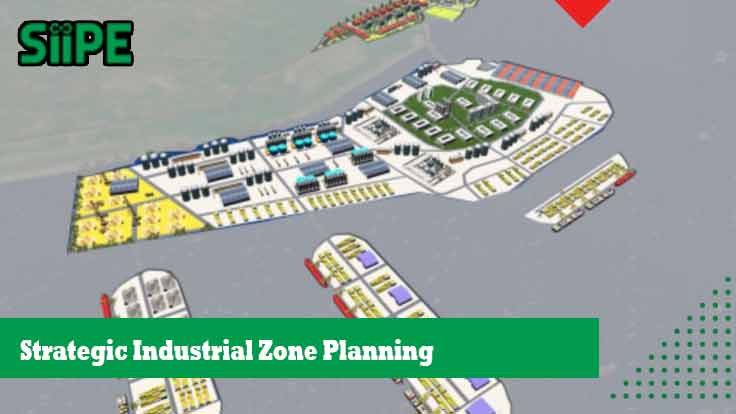In an era of rapid industrialization and globalization, Strategic Industrial Zone Planning has become a cornerstone of sustainable economic development. Proper planning doesn’t only support local economies—it also positions a region competitively on a global scale.
Industrial zones serve as engines of economic growth, job creation, and innovation. However, to harness their full potential, meticulous planning is required—covering infrastructure, logistics, environment, policy frameworks, and market alignment.
This article explores what strategic planning for industrial zones entails, key success factors, and why it is crucial for governments, developers, and investors alike.
What Is Strategic Industrial Zone Planning?
Strategic Industrial Zone Planning refers to the process of designing and organizing industrial areas to ensure they are efficient, sustainable, and economically viable. This includes:
-
Site selection and land use planning
-
Infrastructure layout (roads, power, water, broadband)
-
Integration with transport networks (ports, rail, highways)
-
Environmental and social impact management
-
Policy alignment and incentive structuring
-
Clustering industries for synergy and competitiveness
Strategic planning ensures that industrial zones are not only places for factories but become ecosystems that attract investment, foster innovation, and minimize negative externalities.
Why Strategic Planning Is Critical
1. Long-Term Economic Impact
Poorly planned zones often become underutilized, suffer from logistical bottlenecks, or face community resistance. In contrast, strategically designed zones attract foreign direct investment (FDI), generate employment, and boost local supply chains.
2. Efficient Land Use
As land becomes increasingly scarce, strategic planning ensures optimal land use, including:
-
Zoning for various industry types
-
Environmental buffer zones
-
Future expansion areas
3. Infrastructure Readiness
Industrial development requires massive infrastructure—power, water, waste treatment, and high-speed internet. Planning ahead ensures these utilities are scaled correctly and available from day one.
Key Elements of Strategic Industrial Zone Planning
1. Location Analysis
Location is everything. A strategic site:
-
Is close to labor markets
-
Has access to major logistics corridors
-
Minimizes environmental disruption
-
Has proximity to suppliers and consumers
Geospatial tools and GIS (Geographic Information Systems) are often used to assess potential sites against economic, environmental, and logistical criteria.
2. Industrial Clustering
Grouping related industries in one zone enhances:
-
Supply chain efficiency
-
Technology transfer and innovation
-
Workforce specialization
For example, a food processing cluster benefits from shared cold storage, logistics, and testing facilities. Clusters reduce operational costs and foster collaboration.
3. Infrastructure and Utilities
Strategic planners must anticipate future needs—not just today’s. This includes:
-
Roads designed for heavy vehicles
-
Rail sidings and container depots
-
Smart grids and renewable energy integration
-
Water and wastewater systems
-
Broadband and data center access
Zones that incorporate smart infrastructure are better positioned to attract high-tech industries.
4. Sustainability and Environmental Management
Modern industrial planning emphasizes environmental responsibility. Key strategies include:
-
Environmental Impact Assessments (EIA)
-
Waste recycling and circular economy principles
-
Green buffer zones and pollution control
-
Carbon reduction targets and ESG reporting
Environmentally conscious zones have better access to green financing and face less opposition from local communities.
5. Policy and Regulatory Framework
An industrial zone cannot thrive without enabling policies:
-
Tax holidays or duty exemptions
-
Streamlined business licensing
-
Labor regulations aligned with industry needs
-
Intellectual property protection for R&D-heavy sectors
Public-private partnerships (PPPs) often play a role in aligning government incentives with developer goals.
6. Workforce Development and Housing
Skilled labor availability is a major factor in investor decisions. Strategic plans often include:
-
Technical training centers
-
On-site dormitories or nearby housing
-
Public transport connectivity
Social infrastructure—like healthcare, schools, and recreation—adds further appeal.
Case Studies of Successful Strategic Planning
📍 Jurong Industrial Estate – Singapore
One of the world’s most successful examples, Jurong integrates high-tech clusters, residential zones, and green spaces. The masterplan included:
-
Long-term infrastructure phasing
-
Maritime and logistics access
-
R&D hubs alongside manufacturing
📍 Shenzhen Special Economic Zone – China
Strategic planning turned Shenzhen from a fishing village into a global tech hub. Key elements:
-
Proximity to Hong Kong logistics
-
Incentives for electronics manufacturing
-
Integrated urban-industrial planning
Challenges in Strategic Industrial Zone Planning
Despite its importance, strategic planning faces hurdles:
-
Political instability: Changes in policy can disrupt long-term plans
-
Financing gaps: Infrastructure requires large capital investments
-
Land acquisition issues: Delays or legal disputes with landowners
-
Mismatch with market needs: Building a zone that doesn’t align with investor demand
Planners must continuously adapt strategies to global economic trends, environmental regulations, and technological shifts.
The Role of Technology in Planning
Modern tools like AI, digital twin modeling, and predictive analytics are transforming how planners design industrial zones. With simulations, they can predict:
-
Traffic flows and congestion points
-
Energy demands and emissions
-
Utility capacity over time
-
Risk assessment for climate resilience
Technology helps reduce planning errors and supports data-driven decisions.
Looking Ahead: Future Trends
The next generation of industrial zones will focus on:
-
Net-zero carbon zones
-
Circular industrial ecosystems (waste of one becomes input for another)
-
Digital industrial parks with full 5G, IoT, and AI infrastructure
-
Mixed-use integration (work, live, and innovate in one space)
Zones that can adapt to these trends will remain globally competitive.
Strategic Industrial Zone Planning is not just a matter of drawing lines on a map—it is a multidisciplinary effort involving economics, engineering, environment, governance, and community development. Done right, it creates resilient, profitable, and sustainable industrial ecosystems.
Governments and developers must treat planning not as a checklist but as a vision—a vision for long-term prosperity, environmental stewardship, and global integration.











